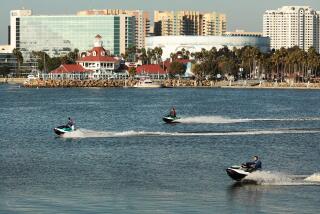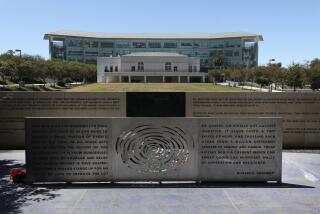School Expansion Proceeds Despite State Budget Crunch
- Share via
The Long Beach Unified School District broke ground this week for the new Mary Butler School, part of a $64-million, five-year expansion that includes three other primary schools, an adult school and five science buildings.
Before the flurry of construction began in 1989, the district had not built a new school in 20 years.
The expansion projects, financed largely by the state, will make room for 6,000 students, and Long Beach schools need every bit of the class space.
Enrollment in the state’s third largest district grew by 3,000 this year, after growing by about 1,000 each year since 1980. By 1995, district officials expect enrollment to grow by 13,000 more students.
The expansion is under way even though the state school construction fund has a $5.5-billion backlog of approved projects it cannot pay for.
Three factors made Long Beach a preferred district for receiving school construction money from the state, said Bill Van Gundy, executive officer of the State Allocation Board. Long Beach has skyrocketing enrollment, officials have approved a year-round schedule, and the district is helping pay for expansion costs.
District administrators also did some creative maneuvering to get what they wanted.
The district sent Deputy Supt. Ron Bennett to Sacramento last month to salvage the science-building project after the allocation board said it could pay for only three of the five buildings.
Bennett offered to surrender $15 million of state money to renovate eight schools in exchange for the last two science buildings.
“This is new,” the state’s Van Gundy said. “This is the first time someone came in and said we want to swap.”
The state approved the exchange, and the science buildings should be complete by September, 1993.
The trade-off was worth it, Bennett said, because “the priority had to be growth. There was no dissent in the district. Everybody on the staff believed we should go with the science buildings.”
District expansion projects also include four new schools in the central and western areas, where enrollment is growing most rapidly.
One of the schools, International Elementary, consists of 32 portable buildings moved onto land the district rents from the city of Long Beach for $1 a year. That school opened in 1989 for 600 students. Last fall, the district built Alvarado Elementary for 420 students. In the fall of 1992, the Mary Butler School will provide new class space for 646 pupils. Jackie Robinson Elementary is also scheduled to open in 1992 for 800 students. The district moved its maintenance yard to a suburban playground to make room for Robinson School.
The district is also putting more students into its older schools. The district uses about 430 portable classrooms to house more than 19,000 students, Director of Facilities Richard Cassman said.
Last fall, the district moved the adult school from Wilson High School in order to free classrooms there. The adult school moved to portable buildings on the Burroughs Elementary campus. Burroughs is in the flight path of the Long Beach airport, and regulations do not allow such schools to expand unless the students are adults.
This summer, the district will convert metal shops at six middle schools into regular classrooms, increasing capacity by about 250 students.
Seven schools are on year-round schedules to handle more students. Two more will convert in July and about 65 middle and elementary schools will go year-round on July 1, 1994. District officials hope that year-round schooling will allow the school system to absorb the rest of its enrollment surge through the end of the century.
The crowding in Long Beach is symptomatic of problems across the state, said Duwayne Brooks, an assistant superintendent with the state Department of Education.
“The state needs 19 new classrooms a day, seven days a week, for the next five years,” Brooks said.
Voters approved a total of $1.6 billion in school construction bonds last year--$800 million in June and $800 million in November. The money already has been allocated, leaving in limbo state-approved projects that would cost at least $5.5 billion to complete.
All things considered, Long Beach officials said they’ve done well in the competition for state money. But the students keep pouring in.
“We’re not done looking at innovative solutions,” Cassman said, “but the space is tight and we’re anxious. We’re at a point where we don’t see added space coming easily.
“So far, nobody’s sitting outside.”
Long Beach School Construction Projects
The Long Beach Unified School District is in the middle of a five-year, $64-million school construction program to cope with skyrocketing enrollment. The projects listed below will provide classroom space for 6,000 students.
Construction Students Completion Project Cost Housed Date International Elementary $1.2 million 600 Fall, 1989 450 Long Beach Blvd. Alvarado Elementary $5.5 million 420 Fall, 1990 1900 E. 21st St., Signal Hill Moving of adult school $1 million 36* Fall, 1990 Converting metal shops $110,000 250 Fall, 1991** Mary Butler School $9.5 million 646 Fall, 1992** 20th Street and Orange Avenue Jackie Robinson Elementary $9 million 800 Fall, 1992** 151 E. 27th St. Five science buildings $38 million 3,250 Fall, 1992, to Fall, 1993** Total $64.31 million 6,002
* The space that was added has been used for the special-education program, which has fewer students per class than most programs.
** Estimated completion date.
Source: Long Beach Unified School District
More to Read
Sign up for Essential California
The most important California stories and recommendations in your inbox every morning.
You may occasionally receive promotional content from the Los Angeles Times.











